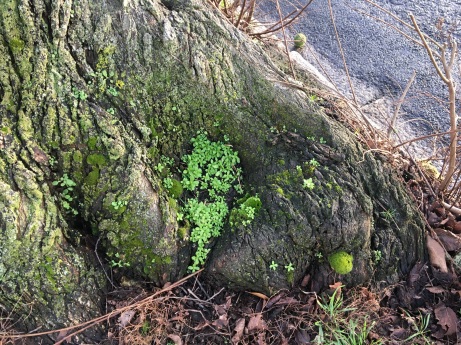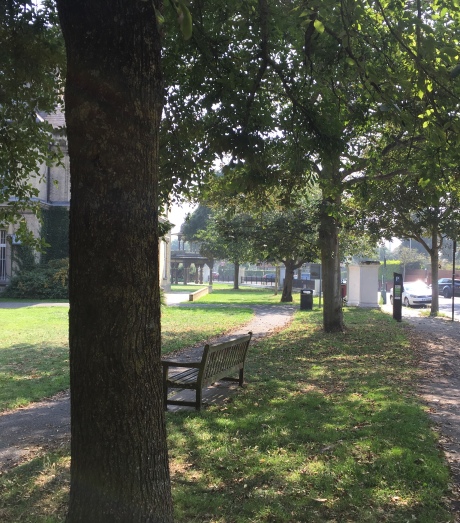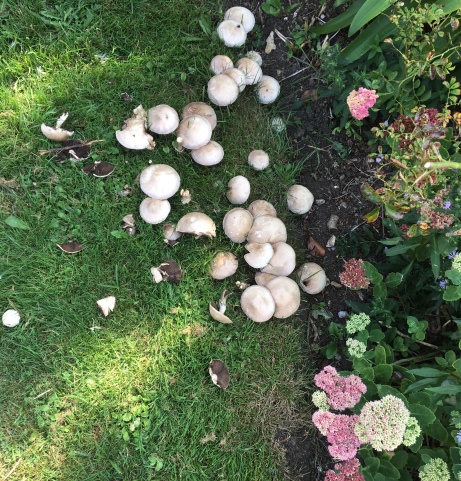Hove
The area just to the west of my home is not rich in bryophytes. As it’s so close I tend to look for mosses while out doing errands; buying bread, DIY supplies and on occasional dog walking duties. It has been a good area to try to get to grips with Syntrichias.
Syntrichia laevipila is frequent on trees in Hove but I first recorded it on an Elm in Adelaide Crescent just off the seafront, found in pouring rain while waiting for the car to be fixed nearby. Local car mechanics all set up shop in the cobbled mews that run parallel to the sea front across the grand avenues in Hove and these will be worth checking for Syntrichia ruralis subsp. ruralis and subsp. ruraliformis which are proving to be strangely elusive in Brighton and Hove.
Syntrichia latifolia crops up a few times in St. Anne’s Well Gardens, growing on damp tarmac and gaps in paving near the pond and on the eastern edge of the park on a leaning ornamental Maple tree. The small stream running from the spring has been disturbed and is devoid of bryophytes but I did find a strand of Leptodictyum riparium on the wooden bridge.
Syntrichia montana was recorded on a gravel path in Adelaide Crescent and more recently on damp tarmac in Silverdale Avenue. It is common on pavements all around town.
Syntrichia papillosa on an Elm in Palmeira square. One of my favourite mosses and quite common on Elms in Brighton and Hove it seems to be more frequent on trees by busy roads. After rain a thick green spongy mass can be seen stretching down one side of host trees but in dry weather it blends into the bark.
The small and scarce Syntrichia virescens was found on a Guernsey Elm on the Upper Drive by Howard Matcham on 21 March 1989. He returned the following week with Rod Stern and found it on Elms along Upper Drive and in October of the same year recorded it on Elms in Dyke Road and this time Francis Rose joined them. I really must go and check these trees.
[On a damp Monday morning in January 2020, before the arrival of storm Brendan, I had a triangular walk, taking in Elm trees on Dyke Road, Old Shoreham Road and The Upper Drive. Howard had warned me that the S. virescens was growing in the dog zone but rain had rinsed the tree bases well and plumped up the mosses. I collected a few samples from Elms in each road and they all looked like good candidates for Syntrichia virescens. Cross sections of the leaves revealed 1-2 rows of stereid cells. Tom checked and confirmed the samples.]

Syntrichia virescens on an Elm on Upper Drive
Hennediella macrophylla is another nice record from this tetrad. A sighting of this riverbank moss in an urban environment was in 1989 in a flower bed in Dyke Road Park opposite the Booth Museum. Nick Hodgetts and Howard Matcham found it nearby in 1990. It is still there in some quantity and a I’ve since found it in St Anne’s Well Gardens near this patch of Mock strawberry.
It was fairly easy to get the records up to the mid thirties but since then I’ve just added one or two species at a time.
I was dog sitting during the wet weather earlier this month which meant many trips to St. Anne’s Well Gardens. A few threads of Plagiomnium threaded through turf under a hedge which Tom confirmed as P. affine. It took me a while to find normally common Lunularia cruciata on paving on Silverdale Avenue which is shaded by railway track side trees. Marchantia polymorpha subsp. ruderalis is frequent on the north side of buildings and this Shaggy Soldier, Galinsoga ciliata was on a south facing wall near Wicks.
In hot and dry weather earlier this week I visited Hove museum and had a quick search for bryophytes in the small garden after looking at the bright paintings of Brighton bathers by Patrick Burke, the latter a more suitable activity for a scorching summer day.
A very small area of turf was still damp in the shade of the yellow brick building and Plagiomnium undulatum was thriving. Phascum cuspidatum was developing capsules and Bryum ruderale had intense violet rhizoids and magenta tubers. All are new for the tetrad. Most of the large trees in the garden are Sycamores but one unidentified tree had a tiny colony of Cololejeunea minutissima.
 A little further east, St. Georges Church has just about survived the arrival of a large Tesco a few years ago, the car park wrapping around the small churchyard. The turf on the north side of the church was lush with Rhytidiadelphus squarrosus, Calliergonella cuspidata and Plagiomnium undulatum but the flint church walls were bare. There were decorative patches of Homalothecium sericeum on some of the tombstones and I was pleased to find grey and tightly curled Didymodon insulanus on a patch of tarmac. Mushrooms grew by the church gate.
A little further east, St. Georges Church has just about survived the arrival of a large Tesco a few years ago, the car park wrapping around the small churchyard. The turf on the north side of the church was lush with Rhytidiadelphus squarrosus, Calliergonella cuspidata and Plagiomnium undulatum but the flint church walls were bare. There were decorative patches of Homalothecium sericeum on some of the tombstones and I was pleased to find grey and tightly curled Didymodon insulanus on a patch of tarmac. Mushrooms grew by the church gate.
Just before publishing this blog piece I walked through Queen’s Place Mews and found small amount of Syntrichia ruralis subsp. ruralis nestled in a loose clump of moss. It was mixed up with Bryum argenteum and Didymodon rigidulus so I think it was kicked from between flint cobbles rather than washed off the slate roof. Pseudocrossidium hornschuchianum was holding tight between the stones. The tetrad TQ20X is now up to 46 taxa but it has taken many trips.




